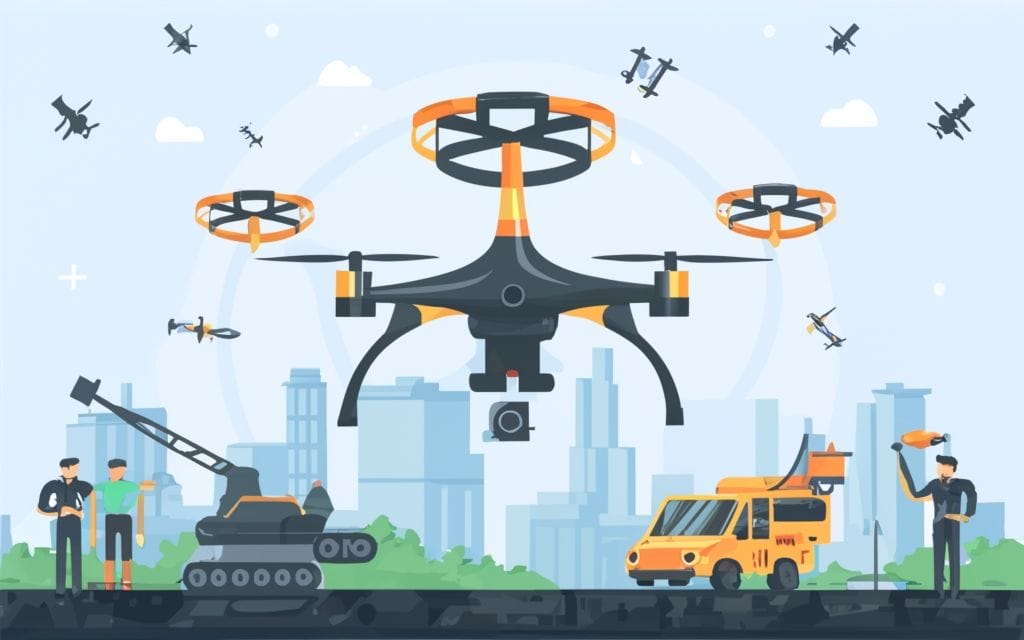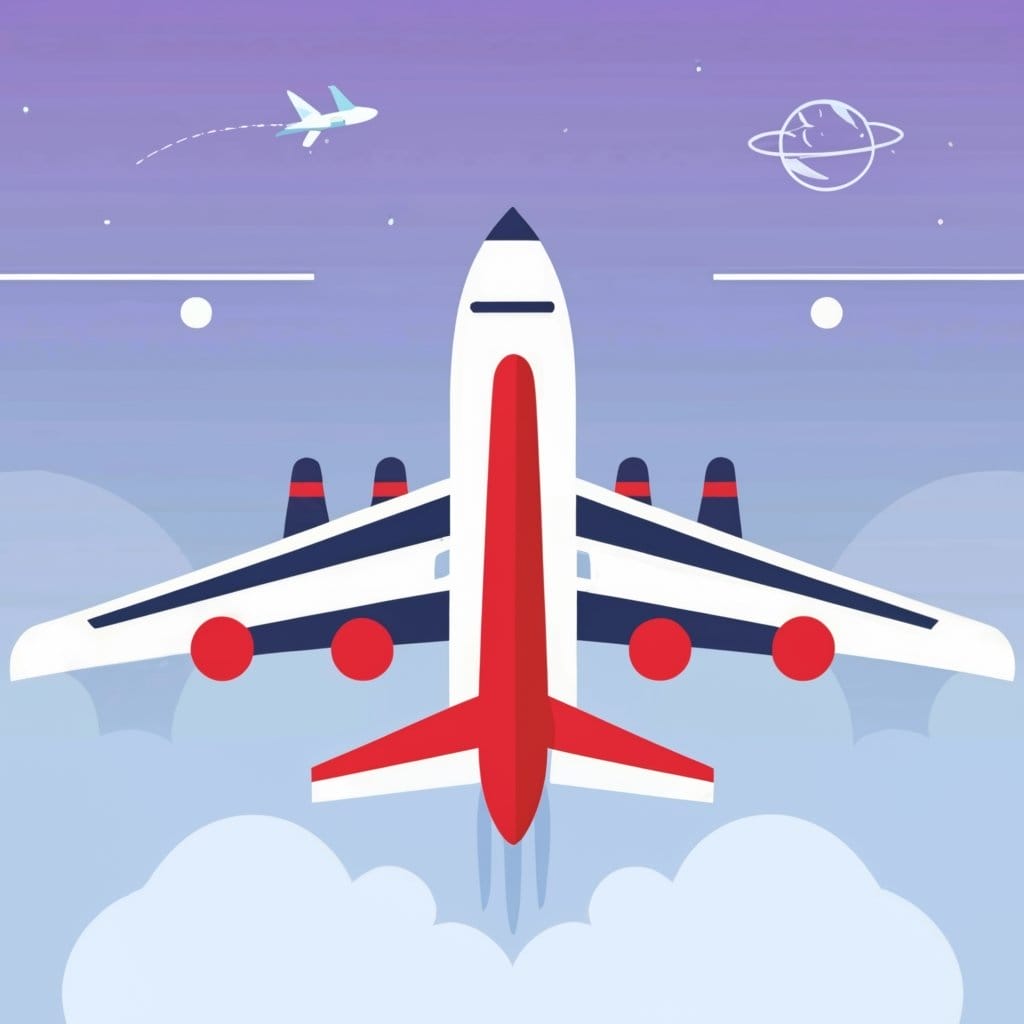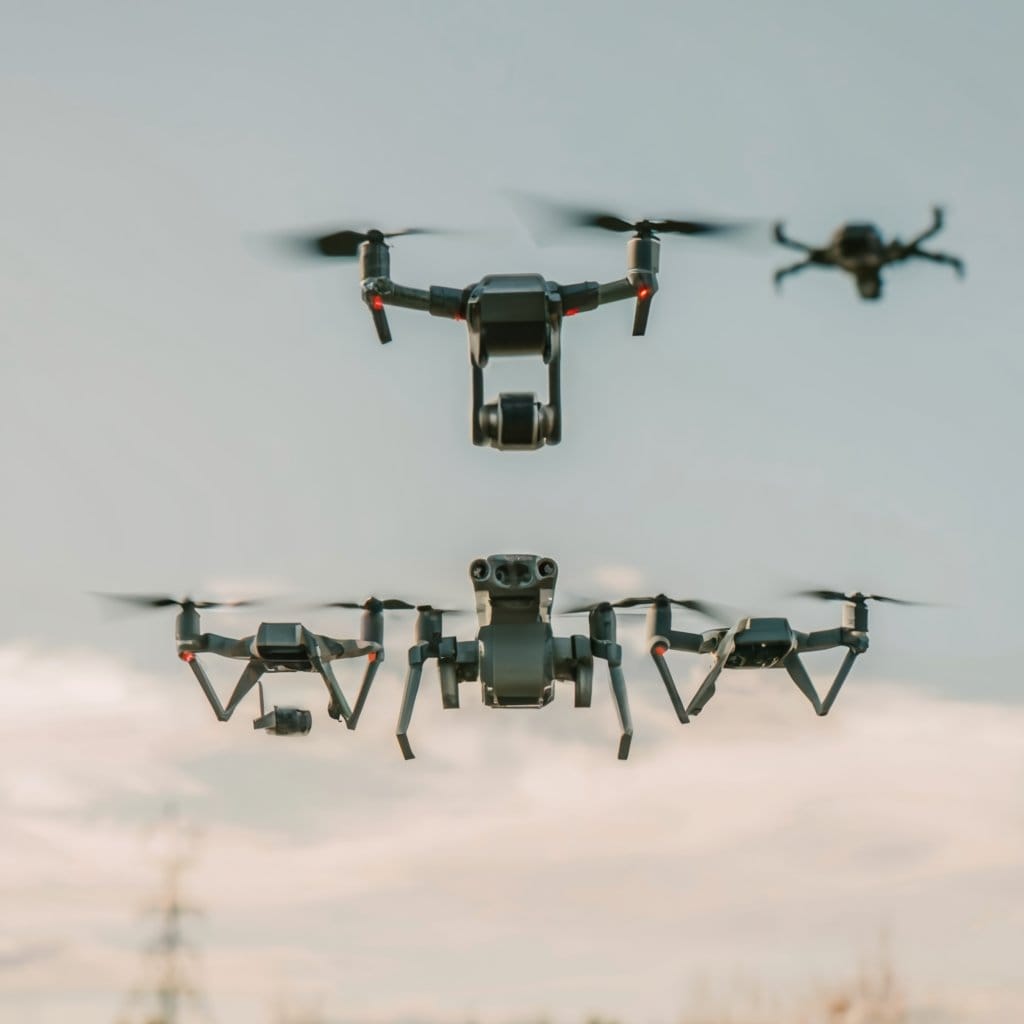Drones have emerged as a transformative technology in various industries, bringing about novel possibilities and efficiencies in unanticipated domains. The influence of drones extends far beyond the commercial sector, with significant ramifications for critical societal functions, such as bolstering security and transforming agriculture practices. The commercial uses of drones are vast, and their impact on our lives is profound. Let’s explore the extensive commercial uses of drones and their profound effect on our lives.

Aerial Photography
The introduction of drones has brought a transformational revolution to the realm of aerial photography. These UAVs have offered photographers, cinematographers, and enthusiasts unparalleled opportunities to capture breathtaking shots from vantage points that were once out of reach, causing a paradigm shift in the industry.
Drones have revolutionized photography by unlocking unique angles and perspectives. They provide creative freedom and adaptability, making aerial photography accessible to a broader audience. Drones have revolutionized property marketing, providing aerial shots that showcase buildings and surrounding landscapes. They are also valuable for capturing memorable moments and events, offering a distinctive viewpoint that adds excitement and visual grandeur.
Surveillance and Security
Drones are powerful tools for optimizing physical security and surveillance, significantly contributing to public safety. Integrating aerial surveillance with drones brings several advantages, revolutionizing traditional security measures. Drones offer quick and efficient monitoring over large areas, providing real-time capabilities that surpass ground-based security systems. Advanced camera technologies capture high-resolution images and videos, aiding in identifying potential threats and securing hard-to-reach sites.
They provide rapid response in security and surveillance scenarios, allowing immediate aerial views of incidents. They are a cost-effective solution for continuous surveillance in various applications. Drones are helpful for surveillance, but privacy concerns must be addressed with guidelines and regulations. Drones are critical for safety and security due to their versatility and agility.
Search and Rescue Operations
Drones are now essential in search and rescue missions, as they provide valuable assistance in locating and rescuing individuals during emergencies. They offer real-time aerial surveillance, giving a bird’s-eye view of the affected areas. This capability helps search and rescue teams to quickly assess the situation, identify potential hazards, and plan efficient rescue strategies.
Drones equipped with advanced cameras and sensors can access challenging terrains, gather crucial data, and identify individuals who require assistance. They improve coordination and reduce response time. They provide real-time data and visuals, aiding decision-making and ensuring an adequate response. Swift deployment is crucial in emergencies, and drones cover large areas quickly, reducing response time.
Drones are becoming increasingly important in search and rescue operations as they can act as communication hubs in areas where infrastructure is disrupted. With Aviation technological advancements, such as AI integration and improved sensors, drones are expected to become even more efficient and impactful. Ultimately, drones have the potential to save lives and mitigate the impact of disasters.
Agriculture and Crop Monitoring
Drone technology has transformed precision farming, introducing efficient crop monitoring methods. Drones play a vital role in assessing crop health and optimizing various aspects of agriculture. Equipped with sensors and cameras, drones enable farmers to collect data remotely. These sensors evaluate soil conditions, monitor crop health, and identify the presence of pests or diseases. This data-driven approach enhances decision-making processes and helps farmers make informed choices about their crops.
Precision agriculture technologies, such as drones, help optimize crop yield by providing detailed information about the condition of crops. High-resolution imaging enables farmers to monitor crop growth and detect changes in health closely, allowing early detection of potential issues. Drones facilitate automated plant counting, helping farmers estimate yields and optimize resource use, reducing costs and environmental impact. Drones have become essential tools in precision farming, providing real-time insights and allowing farmers to make data-driven decisions that can help create sustainable and efficient agriculture.
Use of Drones in Wildlife Conservation
Drones are revolutionizing wildlife conservation through non-invasive, innovative monitoring of habitats. Drones equipped with advanced cameras and sensors offer detailed aerial views of wildlife habitats, which enable researchers to conduct comprehensive surveys, monitor animal populations, and assess the overall health of ecosystems.
Drones offer non-intrusive monitoring without disturbing wildlife. They help track and protect endangered species by capturing high-resolution data on their movements and habitats. Drones aid in anti-poaching efforts by detecting illegal activities and enabling swift responses. They also assist in mapping and monitoring wildlife habitats, helping in conservation efforts, and maintaining ecological balance.
Drones are used in wildlife research with strict guidelines to minimize animal disturbance. They help monitor and preserve ecosystems with enhanced precision, making them an invaluable tool in conservation efforts. Drones have emerged as valuable tools in wildlife conservation, offering a transformative approach to monitoring and preserving ecosystems with enhanced precision and minimal disturbance.
Package Delivery Transformation with Drones
Drones have transformed the logistics industry by revolutionizing package delivery with unprecedented speed and efficiency. Drones are capable of making deliveries quickly by avoiding conventional transportation infrastructure. They can fly directly to destinations and significantly reduce delivery times, especially in areas with congested roadways. Integrating drones in logistics translates to cost savings, especially for short-distance and time-sensitive deliveries. The logistics industry is witnessing continuous innovation in drone technology.
Drones have made significant contributions to solving the last-mile delivery challenge. They can navigate complex routes and deliver packages directly to the doorstep, overcoming obstacles that could delay traditional delivery methods. Additionally, drones are particularly advantageous in reaching remote and inaccessible areas. They facilitate deliveries to locations where conventional transportation might be impractical or costly, ensuring a more inclusive and widespread service.
Disaster Assessment and Response
Drones play a crucial role in disaster assessment and response, offering swift and effective solutions for evaluating disaster-stricken areas and streamlining response efforts. Drones provide rapid aerial assessment capabilities, allowing responders to quickly survey large areas affected by storms, floods, earthquakes, and wildfires. This swift overview aids in understanding the extent of damage and identifying priority areas for intervention.
Drones with high-res cameras and mapping tech provide real-time imagery and accurate maps, aiding disaster response. They can reach hazardous and inaccessible areas, providing insights that may be difficult or dangerous for humans to access. They help in disaster response by quickly assessing damage and identifying needs. They also support search and rescue operations with real-time aerial views and thermal imaging by drones. Drones are cost-effective and efficient, covering large areas quickly and reducing response time.
Construction Site Monitoring
Drones are revolutionizing construction site monitoring by providing real-time insights, improving progress tracking, and enhancing safety. Drones equipped with advanced sensors and GPS technology offer precise data collection capabilities, enabling accurate mapping and real-time monitoring of construction sites. Project managers can track progress dynamically, ensuring that construction stays on schedule.
Drones can enhance construction site safety and resource allocation. They provide a bird’s-eye view for identifying hazards and ensuring compliance with safety protocols. Real-time monitoring allows efficient resource allocation, optimizing workflows, and preventing delays. Drones facilitate streamlined communication among construction teams. Construction teams can collaborate more effectively by using visual overviews of the site to make informed decisions.
Drones in Environmental Monitoring
Drones have become indispensable tools in environmental monitoring, offering innovative solutions to track and assess various aspects of the environment. Drones with sensors can collect real-time air and water quality data and monitor vegetation health and ecosystem conditions.
Drones are used for pollution surveillance and emergency response during environmental disasters. They are cost-effective and efficient for monitoring large areas, and the data collected can inform evidence-based decision-making for environmental policies. They provide a comprehensive understanding of ecological conditions using advanced sensors.
Drones in Film and Entertainment
Drones have significantly impacted the film and entertainment industry, revolutionizing cinematography and offering dynamic filming possibilities that were once unimaginable. Drones equipped with cameras enable filmmakers to capture breathtaking aerial shots. This capability has transformed how movies and TV shows depict landscapes, cityscapes, and action sequences.
Drones offer a cost-effective option for capturing aerial footage, especially compared to traditional methods such as helicopters or cranes. This affordability means filmmakers with varying budgets can now incorporate stunning aerial visuals into their productions. Drones are also highly agile and flexible, allowing filmmakers to shoot in challenging locations or dynamic environments. This versatility enhances creativity by providing unconventional and innovative filming angles.
Drones are now a crucial tool in filmmaking. They capture unique and dynamic angles, making action sequences more captivating and realistic. They also speed up the production process, helping to obtain aerial footage more efficiently and reducing production timelines. They offer new creative possibilities for filmmakers. They can try new techniques and perspectives, enriching the cinematic experience. Filmmakers can also monitor live footage, making immediate adjustments for desired shots without extensive post-production.
Drones in Event Coverage
Drones have revolutionized event coverage by providing captivating and immersive footage from unique angles. Drones enable dynamic and fluid camera movements, allowing for unique angles and perspectives that traditional cameras may struggle to achieve. This provides viewers with a fresh and engaging visual experience. Including drones in events and organizing allows for capturing stunning aerial views of venues and surrounding areas, giving the audience context and a sense of scale and adding visual appeal.
The combination of ground cameras and drones enhances storytelling during events. Drones can navigate spaces that are challenging for conventional cameras. This ability increases visibility, especially in large or crowded events, ensuring no moment is missed. They offer speed and agility in capturing fast-paced events. They can smoothly follow dynamic movements, such as sports or performances, providing a sense of immediacy to the audience. Journalists benefit from drones by gaining a unique aerial perspective on events. This adds depth to news coverage, providing a comprehensive understanding of the situation.
Meteorological Drones
Meteorological drones are crucial in collecting comprehensive weather data, significantly enhancing forecasting capabilities, and facilitating meteorological research. They are equipped with sensors that measure vital weather parameters such as temperature, humidity, air pressure, wind speed, and direction. This allows for collecting precise and real-time data, essential for accurate weather predictions.
Drones can provide atmospheric profiling by reaching different altitudes and gathering data from various levels of the atmosphere. Drones are becoming increasingly crucial for meteorology as they can fly over diverse terrains and navigate difficult weather conditions, helping to fill gaps in existing meteorological networks. Ongoing research is exploring the potential of drones in meteorology, focusing on their role in studying phenomena such as hurricanes, tornadoes, and other extreme weather events.
The Global Hawk project is an initiative that utilizes specialized drones for data collection missions. These drones fly at high altitudes and play a vital role in atmospheric research and monitoring. Meteorological drones are also essential in advancing weather forecasting and analysis by providing real-time, precise data and enhancing our understanding of complex atmospheric conditions.
Drones in Oil and Gas Inspection
Drones have become indispensable tools in the oil and gas industry, transforming exploration and inspection processes. Drones enable efficient inspection of oil and gas infrastructure, including pipelines, refineries, and drilling rigs. They provide high-resolution imagery and real-time data, facilitating quick identification of issues. Drones can proactively detect leaks in pipelines with advanced sensors. This capability aids in preventing environmental damage and ensures the safety of the infrastructure. They are deployed to assess remote and hazardous areas that are challenging for humans to access.
Drones play a crucial role in emergency response scenarios. In the event of a fire or other incidents, drones can provide real-time video feeds to first responders, helping them assess the situation and plan their response effectively. Drones offer a cost-effective and efficient solution for monitoring pipeline integrity, identifying potential issues, and ensuring the smooth flow of resources. They capture valuable data for geological surveys, which allows companies to make informed decisions about potential drilling sites.
Drones collect large volumes of data during inspections and exploration. The use of drones in oil and gas significantly reduces operational costs associated with manual inspections. Moreover, drones contribute to improved safety standards by minimizing the need for human workers to enter hazardous environments. They have become a game-changer in the oil and gas industry, enhancing efficiency, safety, and decision-making in exploration and inspection processes.
Rise of Recreational Drone Enthusiasts
Drones have witnessed a surge in popularity among enthusiasts, marking a significant trend in recreational drone flying. The recreational UAV market is projected to experience substantial growth, with a forecasted compound annual growth rate (CAGR). This indicates a rising trend in drone adoption for leisure activities.
The drone market in the United States is expected to grow 1.18% by 2028, resulting in a market volume of US$1.4 billion. This projected increase highlights the growing popularity of recreational drone use. Drone technology has found diverse applications, including recreational use. In 2019, nearly one million recreational operators were registered, indicating the widespread interest in personal drone technology.
Drones are not just for military purposes anymore. This shift suggests a growing interest in non-military and hobbyist drone activities. People now use them for recreational purposes like racing, displays, and contests. The growth in recreational drone usage and the handsome salary of drone pilots suggest an increase in drone enthusiasts, reflecting the increasing appeal of drone flying as a leisure pursuit. The top drone trends for the future involve growth in recreational drone usage, emphasizing its importance in the drone industry.
Geographical Mapping with Drones in Urban Planning
Drones have significantly transformed urban planning and research by providing advanced capabilities for geographical mapping. Geolocation-driven drones have a crucial role in environmental analysis for urban planning, as they offer detailed insights into terrain and landscape features. This, in turn, leads to a better understanding of the current state of the environment and supports sustainable planning.
Drones offer massive potential for Geographic Information Systems (GIS) professionals. They can capture high-resolution imagery for topographic surveys, aiding in infrastructure planning. Integrating drones with GIS enables monitoring changes in urban landscapes, providing valuable data for planners. Drones also offer historical and contemporary perspectives, allowing planners to analyze the evolution of urban areas over time. They’re low-cost, easy to use, and versatile tools for community-focused geographical studies.
Drones have revolutionized urban planning and research. They provide high-resolution imagery for topographic surveys, mapping, and monitoring changes in urban landscapes. Drone imaging enables planners to analyze the evolution of urban areas over time, making informed decisions based on historical data. They are low-cost, easy-to-use, and versatile tools for researchers and planners engaged in community-focused geographical studies.
Drones in Sports
Drones have revolutionized the sports field by significantly changing analysis, coaching, and capturing dynamic moments. Drones equipped with geolocation technology provide an aerial perspective of sports action, hovering over players and capturing dynamic shots from various angles. This technology improves sports coverage by providing unique views during live events.
Drones are increasingly used in soccer training and analysis. They capture aerial footage to help coaches review player movements, strategies, and team dynamics. This contributes to strategic improvements in gameplay. Drones are revolutionizing Japanese sports by capturing unique and dynamic footage that was previously difficult to obtain. The NFL uses drones to film various aspects of their activities and practices, providing coaches with valuable material for analyzing and improving player performance.
Drones in Education
Drones are increasingly used as practical educational tools, providing students with hands-on learning experiences in various academic disciplines. They offer a unique platform for integrating STEM (Science, Technology, Engineering, and Mathematics) subjects, allowing students to explore concepts from multiple fields and develop a holistic understanding of STEM disciplines. Drones provide a wide range of learning experiences, from understanding aerodynamics and physics to programming and coding for autonomous flight, making them valuable tools for cultivating a broad student skill set.
Drones in K-12 education provide real-life applications for mapping, photography, and environmental monitoring. They serve as gateways to emerging technologies, introducing students to agriculture and environmental science. After-school programs utilizing drones prepare students for the technological future. They provide hands-on learning experiences that enhance STEM skills and critical thinking. They are versatile educational tools that help students learn to apply scientific principles and solve problems.
Diverse Commercial Uses of Drones: Transformative Impact
The use of drones has revolutionized the way we carry out various tasks in our daily lives. These unmanned aerial vehicles have significantly changed many industries, including agriculture, media, environmental conservation, emergency response, industry, and logistics. In agriculture, drones monitor crop health, collect data, and spray pesticides, increasing efficiency and yield. The media industry has also benefited from drones, as they can capture stunning aerial footage that was once impossible to obtain.
Drones have also played a vital role in environmental conservation, as they can be used to monitor wildlife and identify areas that need protection. In emergency response, drones assess the damage after natural disasters, locate missing persons, and deliver essential supplies to inaccessible areas. Drones have also transformed the logistics industry, as they can be used to deliver packages quickly and efficiently. With the advancement of technology, the role of drones in our lives is expected to expand even further, making them an increasingly crucial part of modern society.



